Check Stingray’s dead time model¶
Here we verify that the algorithm used for dead time filtering is behaving as expected.
We also compare the results with the algorithm for paralyzable dead time, for reference.
[1]:
%load_ext autoreload
%autoreload 2
%matplotlib inline
import matplotlib.pyplot as plt
import seaborn as sns
from matplotlib.gridspec import GridSpec
import matplotlib as mpl
from stingray import EventList, AveragedPowerspectrum
import tqdm
import stingray.deadtime.model as dz
from stingray.deadtime.model import A, check_A, check_B
sns.set_context('talk')
sns.set_style("whitegrid")
sns.set_palette("colorblind")
mpl.rcParams['figure.dpi'] = 150
mpl.rcParams['figure.figsize'] = (10, 8)
mpl.rcParams['font.size'] = 18.0
mpl.rcParams['xtick.labelsize'] = 18.0
mpl.rcParams['ytick.labelsize'] = 18.0
mpl.rcParams['axes.labelsize'] = 18.0
mpl.rcParams['axes.labelsize'] = 18.0
from stingray.filters import filter_for_deadtime
import numpy as np
np.random.seed(1209432)
Non-paralyzable dead time¶
[2]:
def simulate_events(rate, length, deadtime=2.5e-3, **filter_kwargs):
events = np.random.uniform(0, length, int(rate * length))
events = np.sort(events)
events_dt = filter_for_deadtime(events, deadtime, **filter_kwargs)
return events, events_dt
[3]:
rate = 1000
length = 1000
events, events_dt = simulate_events(rate, length)
diff = np.diff(events)
diff_dt = np.diff(events_dt)
[4]:
dt = 2.5e-3/20 # an exact fraction of deadtime
bins = np.arange(0, np.max(diff), dt)
hist = np.histogram(diff, bins=bins, density=True)[0]
hist_dt = np.histogram(diff_dt, bins=bins, density=True)[0]
bins_mean = bins[:-1] + dt/2
plt.figure()
plt.title('Non-Paralyzable dead time')
plt.fill_between(bins_mean, 0, hist, alpha=0.5, label='No dead time');
plt.fill_between(bins_mean, 0, hist_dt, alpha=0.5, label='With dead time');
plt.xlim([0, 0.02]);
# plt.ylim([0, 100]);
plt.axvline(2.5e-3, color='r', ls='--')
plt.xlabel(r'Time between subsequent photons $T_{i+1} - T_{i}$')
plt.ylabel('Probability density')
plt.legend();

Exactly as expected, the output distribution of the distance between the events follows an exponential distribution cut at 2.5 ms.
The measured rate is expected to go as
(Zhang+95, eq. 29). Let’s check it.
[5]:
plt.figure()
plt.title('Non-Paralyzable dead time - input rate {} ct/s'.format(rate))
deadtimes = np.arange(0, 0.015, 0.0005)
deadtimes_plot = np.arange(0, 0.015, 0.0001)
for d in deadtimes:
events_dt = filter_for_deadtime(events, d)
new_rate = len(events_dt) / length
plt.scatter(d, new_rate, color='b')
plt.plot(deadtimes_plot, rate / (1 + rate * deadtimes_plot),
label=r'$\frac{r_{in}}{1 + r_{in}\tau_d}$')
plt.xlim([0, None])
plt.xlabel('Dead time')
plt.ylabel('Output rate')
plt.semilogy()
plt.legend();
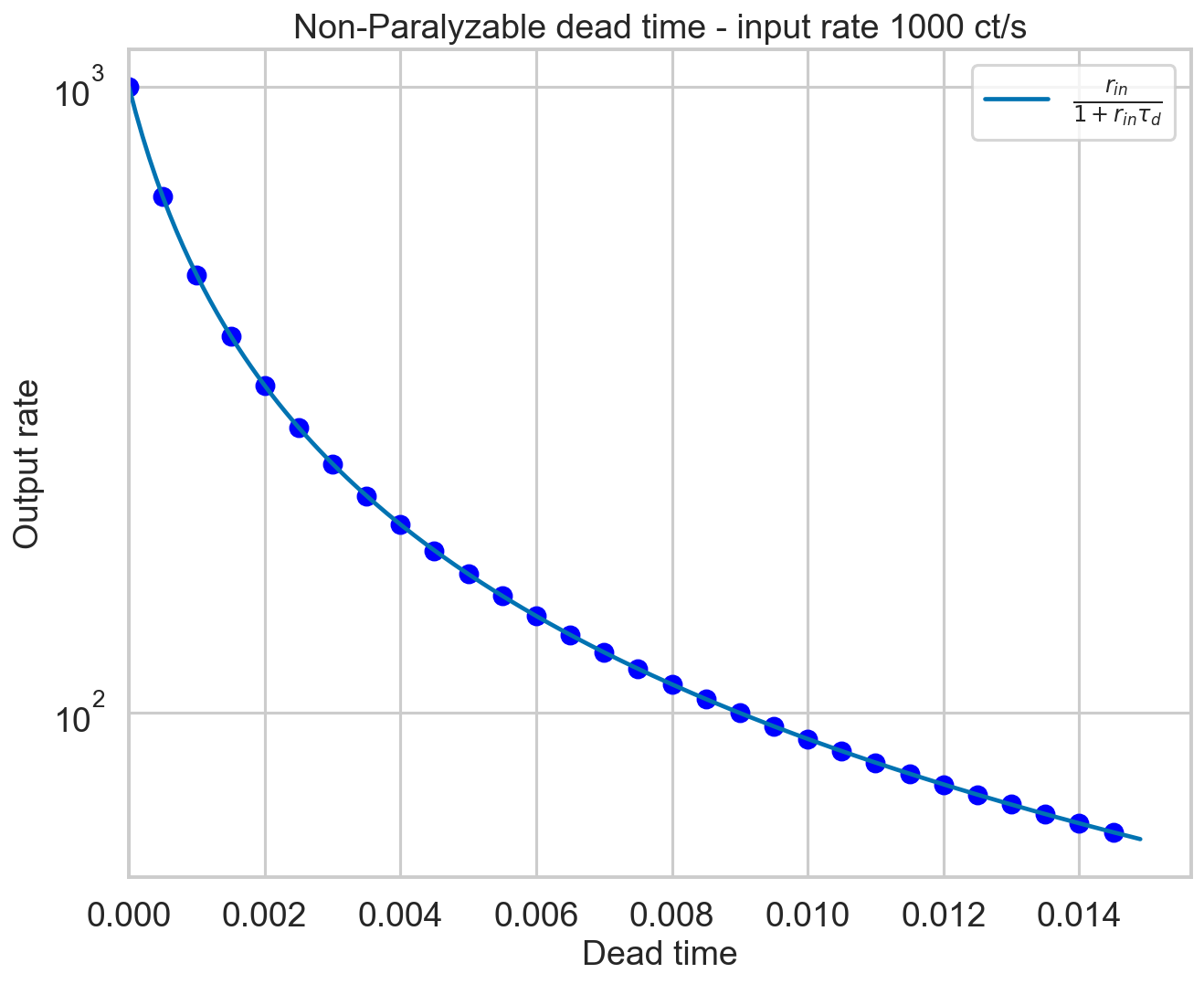
Paralyzable dead time¶
[6]:
rate = 1000
length = 1000
events, events_dt = simulate_events(rate, length, paralyzable=True)
diff = np.diff(events)
diff_dt = np.diff(events_dt)
[7]:
dt = 2.5e-3/20 # an exact fraction of deadtime
bins = np.arange(0, np.max(diff_dt), dt)
hist = np.histogram(diff, bins=bins, density=True)[0]
hist_dt = np.histogram(diff_dt, bins=bins, density=True)[0]
bins_mean = bins[:-1] + dt/2
plt.figure()
plt.title('Paralyzable dead time')
plt.fill_between(bins_mean, 0, hist, alpha=0.5, label='No dead time');
plt.fill_between(bins_mean, 0, hist_dt, alpha=0.5, label='With dead time');
plt.xlim([0, 0.02]);
# plt.ylim([0, 100]);
plt.axvline(2.5e-3, color='r', ls='--')
plt.xlabel(r'Time between subsequent photons $T_{i+1} - T_{i}$')
plt.ylabel('Probability density')
plt.legend();
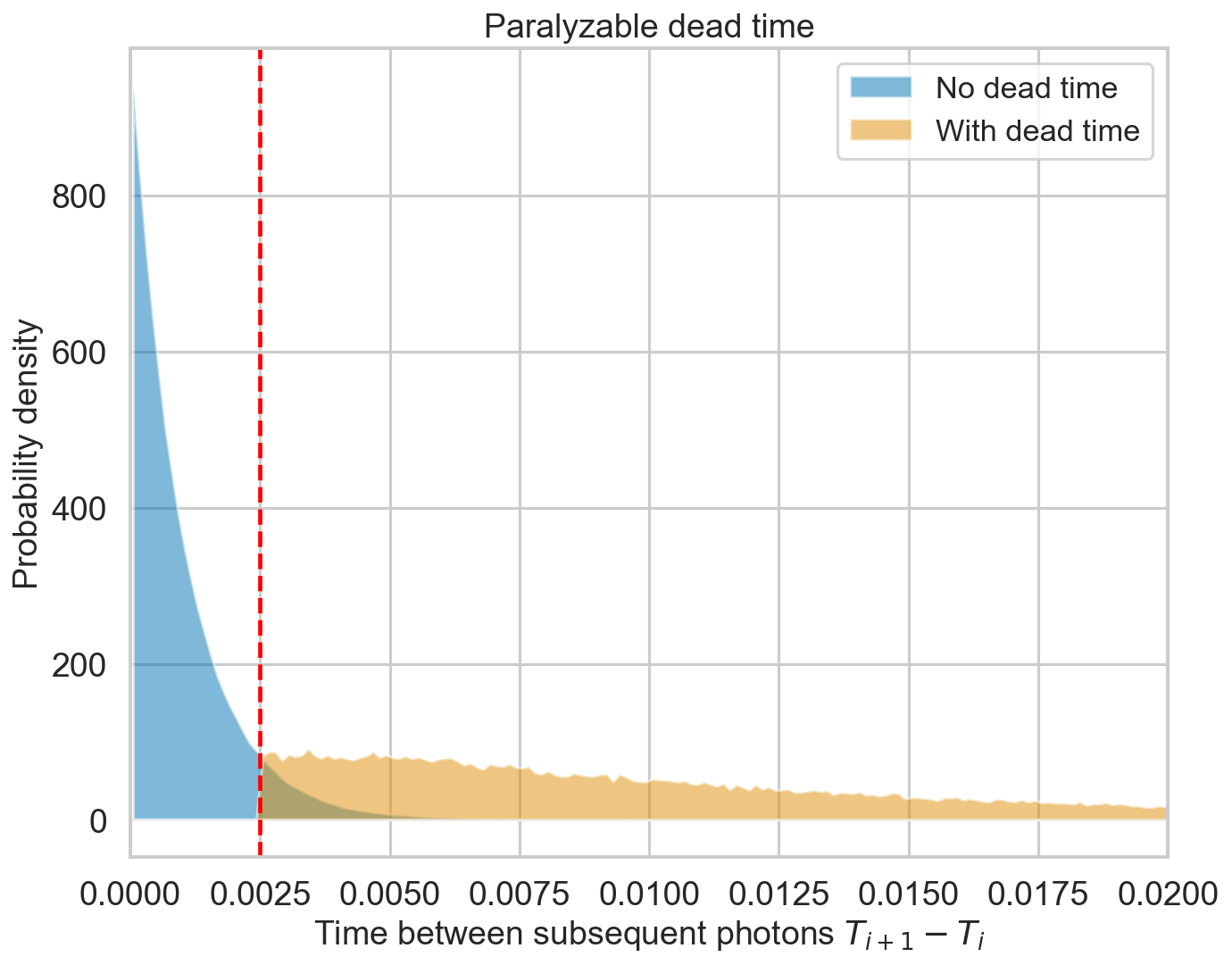
Non-paralyzable dead time has a distribution for the time between consecutive counts that plateaus between \(\tau_d\) and \(2\tau_d\), then decreases. The exact form is complicated (e.g. )
The measured rate is expected to go as
(Zhang+95, eq. 16). Let’s check it.
[8]:
plt.figure()
plt.title('Paralyzable dead time - input rate {} ct/s'.format(rate))
deadtimes = np.arange(0, 0.008, 0.0005)
deadtimes_plot = np.arange(0, 0.008, 0.0001)
for d in deadtimes:
events_dt = filter_for_deadtime(events, d, paralyzable=True)
new_rate = len(events_dt) / length
plt.scatter(d, new_rate, color='b')
plt.plot(deadtimes_plot, rate * np.exp(-rate * deadtimes_plot),
label=r'$r_{in}e^{-r_{in}\tau_d}$')
plt.xlim([0, None])
plt.xlabel('Dead time')
plt.ylabel('Output rate')
plt.semilogy()
plt.legend();

Perfect.
Periodogram - non-paralyzable¶
Let’s see how the periodogram behaves at different intensities. Will it follow the Zhang+95 model?
[9]:
nevents = 200000
rates = np.logspace(2, np.log10(3000), 6)
bintime = 0.001
deadtime = 2.5e-3
plt.figure()
plt.title(f'bin time = 1 ms; dead time = 2.5 ms')
for r in tqdm.tqdm(rates):
label = f'{r} ct/s'
length = nevents / r
events, events_dt = simulate_events(r, length)
events_dt = EventList(events_dt, gti=[[0, length]])
# lc = Lightcurve.make_lightcurve(events, 1/4096, tstart=0, tseg=length)
# lc_dt = Lightcurve.make_lightcurve(events_dt, bintime, tstart=0, tseg=length)
# pds = AveragedPowerspectrum.from_lightcurve(lc_dt, 2, norm='leahy')
pds = AveragedPowerspectrum.from_events(events_dt, bintime, 2, norm='leahy', silent=True)
plt.plot(pds.freq, pds.power, label=label)
zh_f, zh_p = dz.pds_model_zhang(1000, r, deadtime, bintime)
plt.plot(zh_f, zh_p, color='b')
plt.plot(zh_f, zh_p, color='b', label='Zhang+95 prediction')
plt.axhline(2, ls='--')
plt.xlabel('Frequency (Hz)')
plt.ylabel('Power (Leahy)')
plt.legend();
0%| | 0/6 [00:00<?, ?it/s]
INFO: Calculating PDS model (update) [stingray.deadtime.model]
67%|██████▋ | 4/6 [00:02<00:00, 2.50it/s]
INFO: Calculating PDS model (update) [stingray.deadtime.model]
INFO: Calculating PDS model (update) [stingray.deadtime.model]
INFO: Calculating PDS model (update) [stingray.deadtime.model]
INFO: Calculating PDS model (update) [stingray.deadtime.model]
100%|██████████| 6/6 [00:02<00:00, 2.37it/s]
INFO: Calculating PDS model (update) [stingray.deadtime.model]
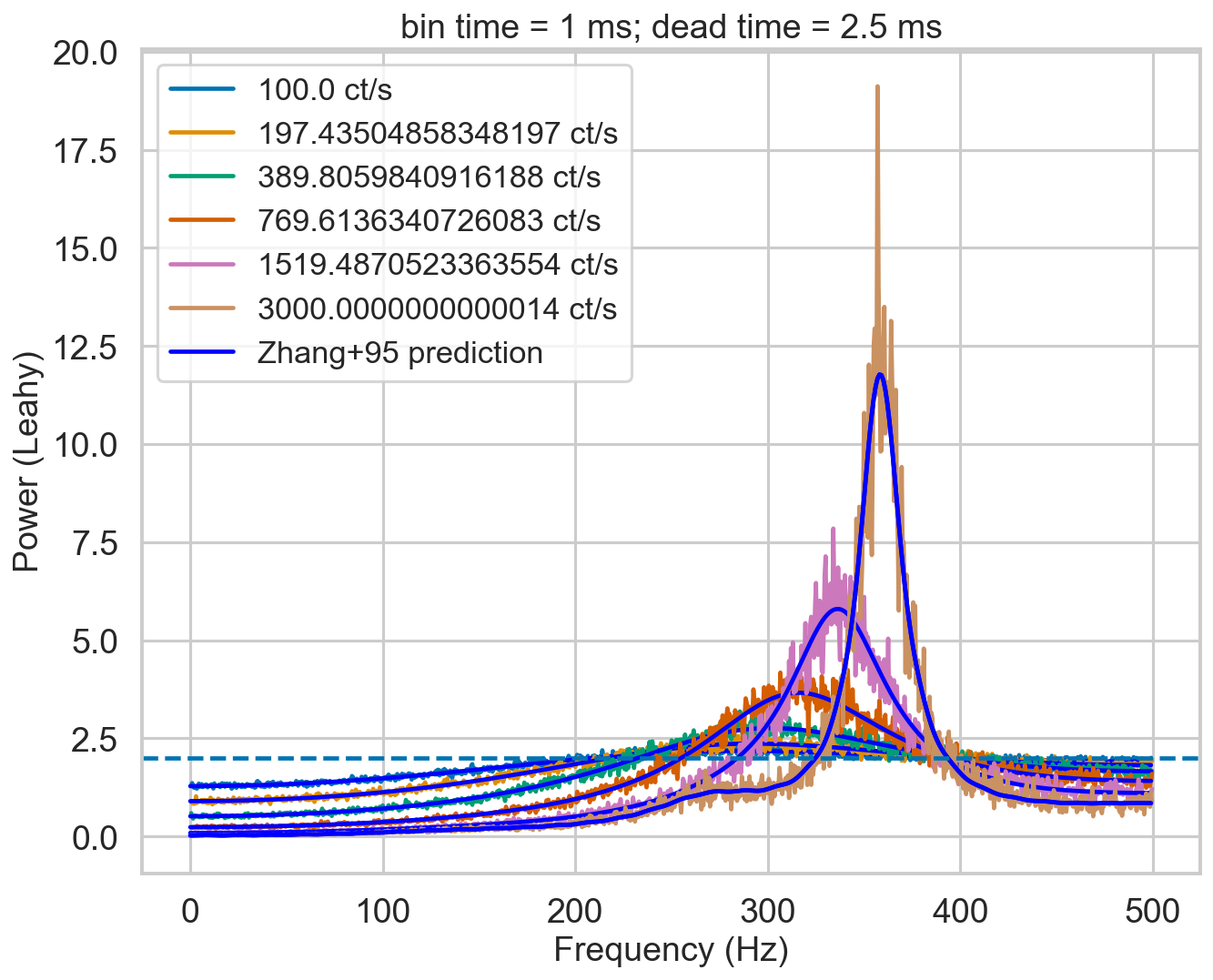
[10]:
from stingray.lightcurve import Lightcurve
from stingray.powerspectrum import AveragedPowerspectrum
import tqdm
nevents = 200000
rates = np.logspace(2, 3, 5)
deadtime = 2.5e-3
bintime = 2 * deadtime
plt.figure()
plt.title(f'bin time = 5 ms; dead time = 2.5 ms')
for r in tqdm.tqdm(rates):
label = f'{r} ct/s'
length = nevents / r
events, events_dt = simulate_events(r, length)
events_dt = EventList(events_dt, gti=[[0, length]])
# lc = Lightcurve.make_lightcurve(events, 1/4096, tstart=0, tseg=length)
# lc_dt = Lightcurve.make_lightcurve(events_dt, bintime, tstart=0, tseg=length)
# pds = AveragedPowerspectrum.from_lc(lc_dt, 2, norm='leahy', silent=True)
pds = AveragedPowerspectrum.from_events(events_dt, bintime, 2, norm='leahy', silent=True)
plt.plot(pds.freq, pds.power, label=label)
zh_f, zh_p = dz.pds_model_zhang(2000, r, deadtime, bintime)
plt.plot(zh_f, zh_p, color='b')
plt.plot(zh_f, zh_p, color='b', label='Zhang+95 prediction')
plt.axhline(2, ls='--')
plt.xlabel('Frequency (Hz)')
plt.ylabel('Power (Leahy)')
plt.legend();
0%| | 0/5 [00:00<?, ?it/s]
INFO: Calculating PDS model (update) [stingray.deadtime.model]
20%|██ | 1/5 [00:01<00:04, 1.20s/it]
INFO: Calculating PDS model (update) [stingray.deadtime.model]
40%|████ | 2/5 [00:02<00:03, 1.11s/it]
INFO: Calculating PDS model (update) [stingray.deadtime.model]
60%|██████ | 3/5 [00:03<00:02, 1.07s/it]
INFO: Calculating PDS model (update) [stingray.deadtime.model]
80%|████████ | 4/5 [00:04<00:01, 1.09s/it]
INFO: Calculating PDS model (update) [stingray.deadtime.model]
100%|██████████| 5/5 [00:05<00:00, 1.09s/it]
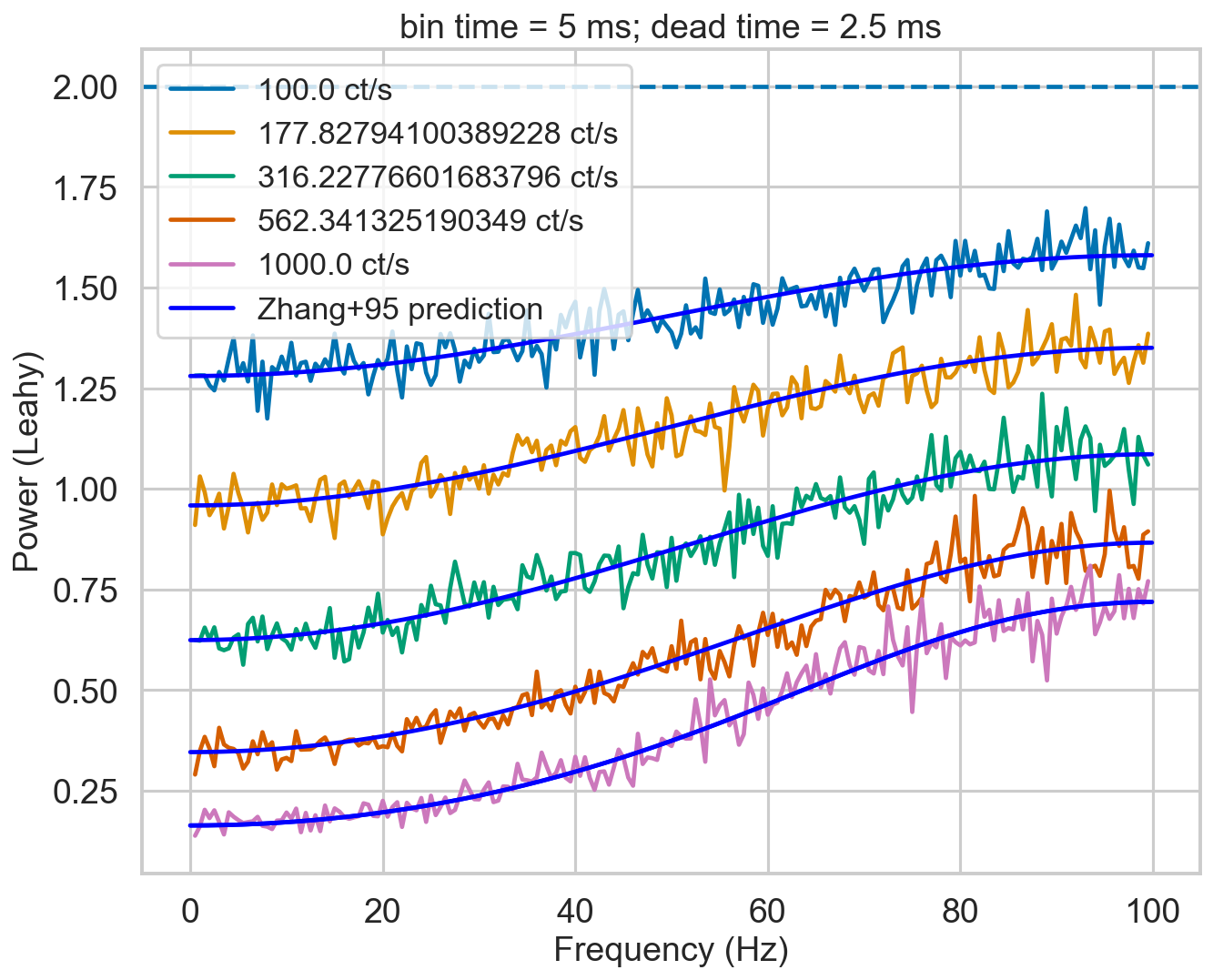
It will.
Reproduce Zhang+95 power spectrum? (extra check)¶
[11]:
from stingray.lightcurve import Lightcurve
from stingray.powerspectrum import AveragedPowerspectrum
import tqdm
bintime = 1e-6
deadtime = 1e-5
length = 40
fftlen = 0.01
plt.figure()
plt.title(f'bin time = 1 us; dead time = 10 us')
r = 20000
label = f'{r} ct/s'
events, events_dt = simulate_events(r, length, deadtime=deadtime)
events_dt = EventList(events_dt, gti=[[0, length]])
# lc = Lightcurve.make_lightcurve(events, 1/4096, tstart=0, tseg=length)
# lc_dt = Lightcurve.make_lightcurve(events_dt, bintime, tstart=0, tseg=length)
# pds = AveragedPowerspectrum.from_lightcurve(lc_dt, fftlen, norm='leahy')
pds = AveragedPowerspectrum.from_events(events_dt, bintime, fftlen, norm='leahy')
plt.plot(pds.freq / 1000, pds.power, label=label, drawstyle='steps-mid')
zh_f, zh_p = dz.pds_model_zhang(2000, r, deadtime, bintime)
plt.plot(zh_f / 1000, zh_p, color='r', label='Zhang+95 prediction', zorder=10)
plt.axhline(2, ls='--')
plt.xlabel('Frequency (kHz)')
plt.ylabel('Power (Leahy)')
plt.legend();
4000it [00:00, 4140.55it/s]
INFO: Calculating PDS model (update) [stingray.deadtime.model]

Ok.
An additional note on the Zhang model: it is a numerical model, with multiple nested summations that are prone to numerical errors. The assumptions made in the Zhang paper (along the line of “in practice the number of terms needed is very small…”) are assuming the case of RXTE, where 1/dead time was low with respect to the incident rate. This is true in the simulation in figure 4 of Zhang+95: 20,000 ct/s incident rate, 1/dead time = 100,000. However, this is not true in NuSTAR, depicted in our simulation below where the incident rate (2,000) is much larger than 1/dead time (400). A thorough estimate of the needed level of detail (that implies increasing the number of summed terms) versus increase of numerical errors has to be done. This is a quite long procedure, and I did not go into so much detail. This is the reason of the “wiggles” that can be seen in the model in red in the plot below.
[12]:
bintime = 1/4096
deadtime = 2.5e-3
length = 8000
fftlen = 5
r = 2000
plt.figure()
plt.title(f'bin time = {bintime} s; dead time = {deadtime} s')
label = f'{r} ct/s'
events, events_dt = simulate_events(r, length, deadtime=deadtime)
events_dt = EventList(events_dt, gti=[[0, length]])
# lc = Lightcurve.make_lightcurve(events, 1/4096, tstart=0, tseg=length)
# lc_dt = Lightcurve.make_lightcurve(events_dt, bintime, tstart=0, tseg=length)
# pds = AveragedPowerspectrum.from_lightcurve(lc_dt, fftlen, norm='leahy', silent=True)
pds = AveragedPowerspectrum.from_events(events_dt, bintime, fftlen, norm='leahy', silent=True)
plt.plot(pds.freq / 1000, pds.power, label=label, drawstyle='steps-mid')
zh_f, zh_p = dz.pds_model_zhang(1000, r, deadtime, bintime)
plt.plot(zh_f / 1000, zh_p, color='r', label='Zhang+95 prediction', zorder=10)
plt.axhline(2, ls='--')
plt.xlabel('Frequency (kHz)')
plt.ylabel('Power (Leahy)')
plt.legend();
INFO: Calculating PDS model (update) [stingray.deadtime.model]
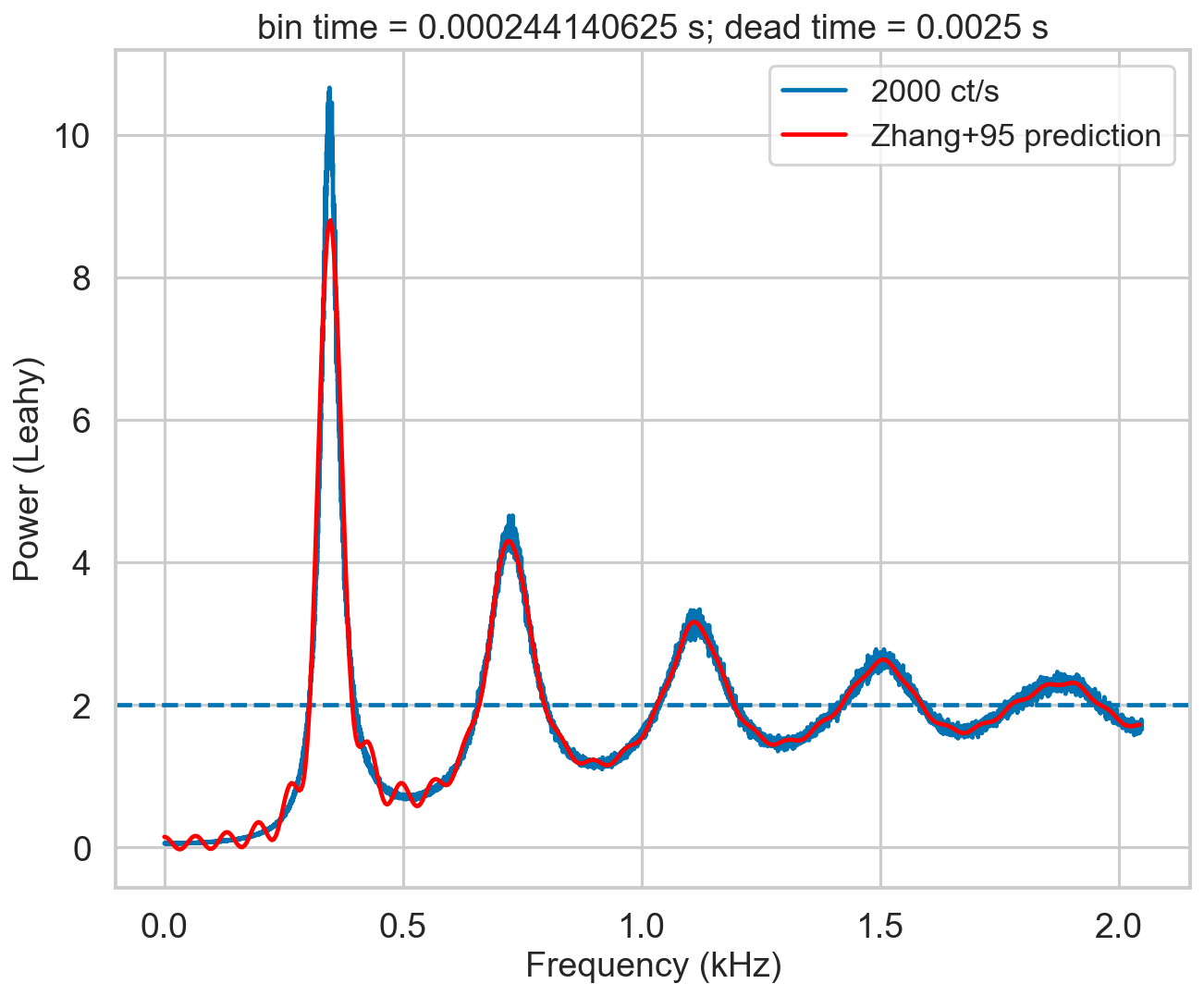
The script check_A checks visually the number of ks to calculate before going to the approximate value r0**2*tb**2. The default is 60, but in this case the presence of additional modulation for k=60 tells us that we need to increase the limit of calculated A_k to at least 150. The script check_B does this for another important quantity in the model.
Somewhat counter-intuitively, there might be cases where too high values of k could produce numerical errors. Always run check_A and check_B to test it.
[13]:
def safe_A(k, r0, td, tb, tau, limit=60):
if k > limit:
return r0 ** 2 * tb**2
return A(k, r0, td, tb, tau)
check_A(r, deadtime, bintime, max_k=250)
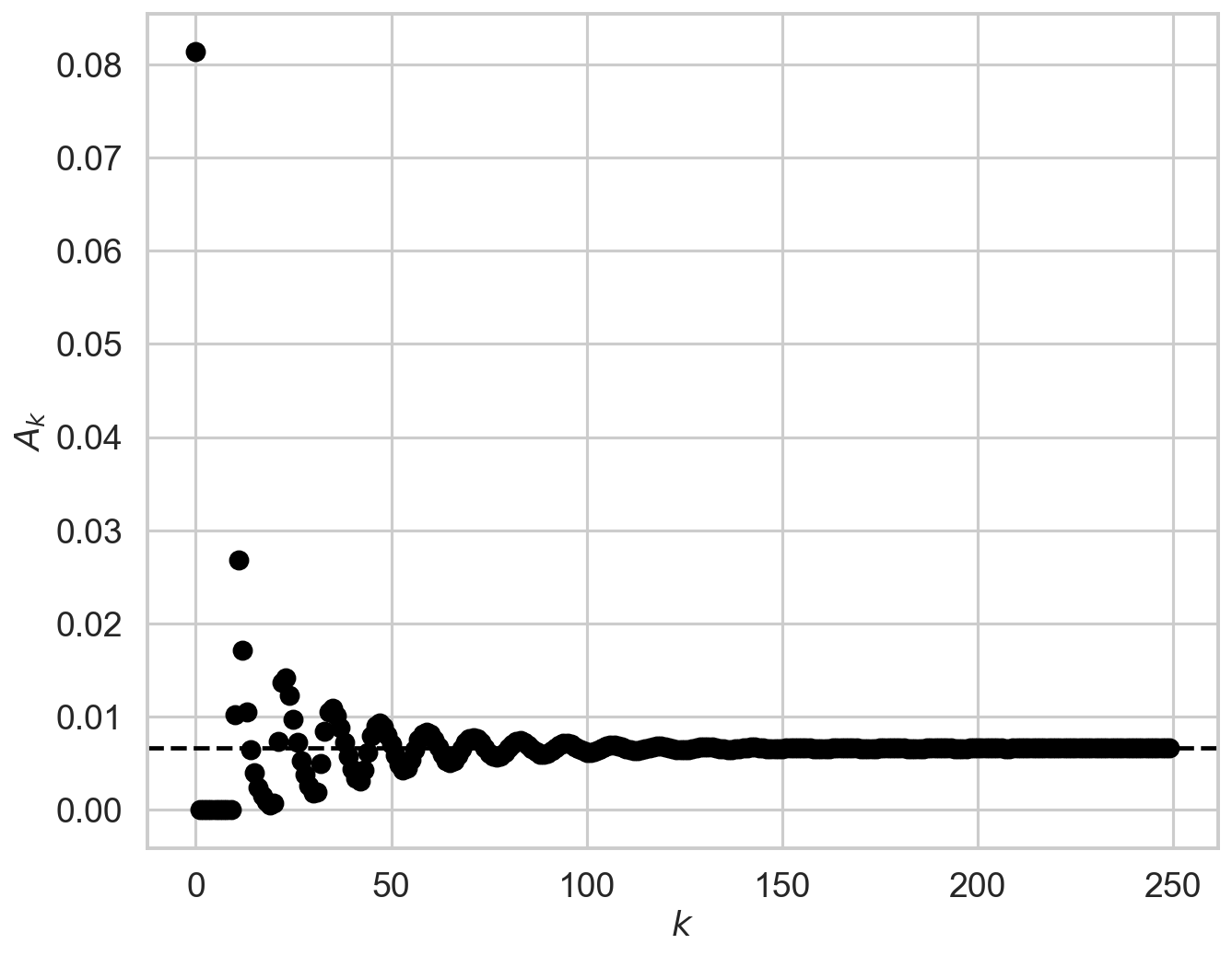
So, we had better repeat the procedure by using limit_k=150 this time.
[14]:
check_B(r, deadtime, bintime, max_k=250)
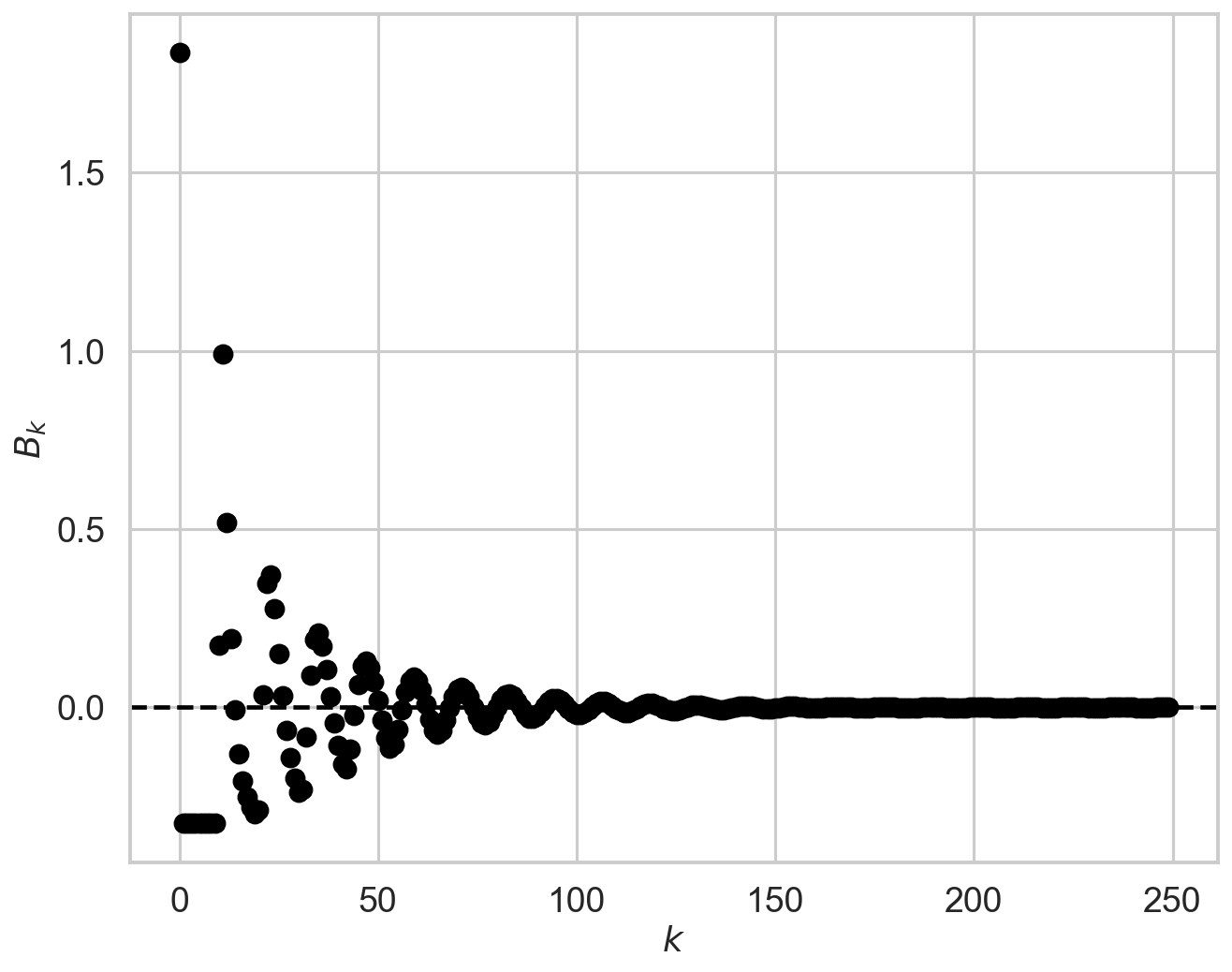
[15]:
bintime = 1/4096
deadtime = 2.5e-3
length = 8000
fftlen = 5
r = 2000
plt.figure()
plt.title(f'bin time = {bintime} s; dead time = {deadtime} s')
label = f'{r} ct/s'
events, events_dt = simulate_events(r, length, deadtime=deadtime)
events_dt = EventList(events_dt, gti=[[0, length]])
# lc = Lightcurve.make_lightcurve(events, 1/4096, tstart=0, tseg=length)
# lc_dt = Lightcurve.make_lightcurve(events_dt, bintime, tstart=0, tseg=length)
# pds = AveragedPowerspectrum(lc_dt, fftlen, norm='leahy')
# lc_dt = Lightcurve.make_lightcurve(events_dt, bintime, tstart=0, tseg=length)
pds = AveragedPowerspectrum.from_events(events_dt, bintime, fftlen, norm='leahy')
plt.plot(pds.freq / 1000, pds.power, label=label, drawstyle='steps-mid')
zh_f, zh_p = dz.pds_model_zhang(1000, r, deadtime, bintime, limit_k=250)
plt.plot(zh_f / 1000, zh_p, color='r', label='Zhang+95 prediction', zorder=10)
plt.axhline(2, ls='--')
plt.xlabel('Frequency (kHz)')
plt.ylabel('Power (Leahy)')
plt.legend();
1600it [00:00, 3214.76it/s]
INFO: Calculating PDS model (update) [stingray.deadtime.model]
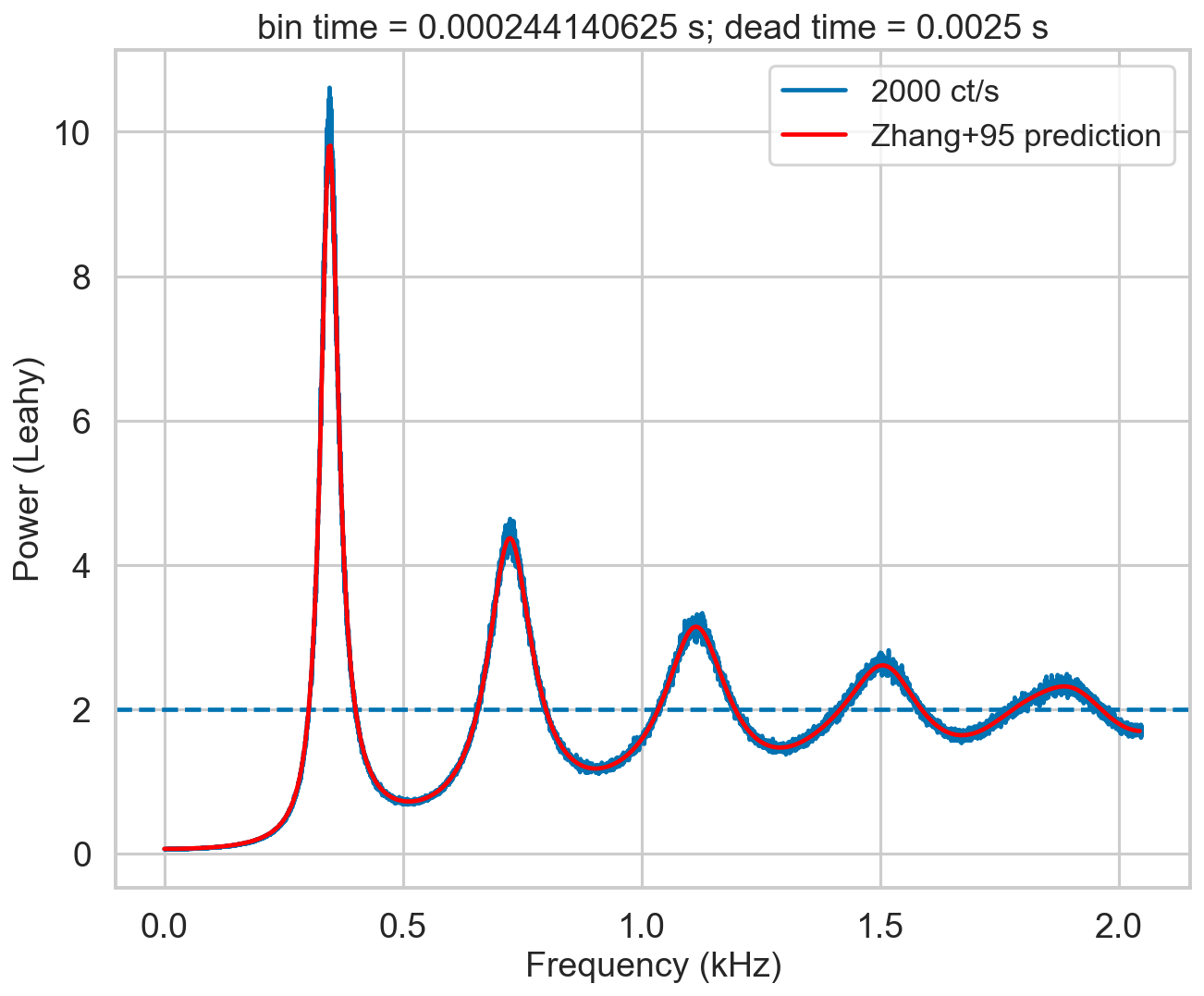
[16]:
from scipy.interpolate import interp1d
deadtime_fun = interp1d(zh_f, zh_p, bounds_error=False,fill_value="extrapolate")
plt.figure()
plt.plot(pds.freq, pds.power / deadtime_fun(pds.freq), color='r', zorder=10)
[16]:
[<matplotlib.lines.Line2D at 0x7f8c9ed78100>]

Still imperfect, but this is a very high count rate case. In more typical cases, the correction is more than adequate:
[17]:
bintime = 1/4096
deadtime = 2.5e-3
length = 8000
fftlen = 5
r = 300
plt.figure()
plt.title(f'bin time = {bintime} s; dead time = {deadtime} s')
label = f'{r} ct/s'
events, events_dt = simulate_events(r, length, deadtime=deadtime)
events_dt = EventList(events_dt, gti=[[0, length]])
# lc = Lightcurve.make_lightcurve(events, 1/4096, tstart=0, tseg=length)
# lc_dt = Lightcurve.make_lightcurve(events_dt, bintime, tstart=0, tseg=length)
# pds = AveragedPowerspectrum(lc_dt, fftlen, norm='leahy')
pds = AveragedPowerspectrum.from_events(events_dt, bintime, fftlen, norm='leahy')
plt.plot(pds.freq / 1000, pds.power, label=label, drawstyle='steps-mid')
zh_f, zh_p = dz.pds_model_zhang(1000, r, deadtime, bintime, limit_k=250)
plt.plot(zh_f / 1000, zh_p, color='r', label='Zhang+95 prediction', zorder=10)
plt.axhline(2, ls='--')
plt.xlabel('Frequency (kHz)')
plt.ylabel('Power (Leahy)')
plt.legend();
1600it [00:00, 3402.34it/s]
INFO: Calculating PDS model (update) [stingray.deadtime.model]
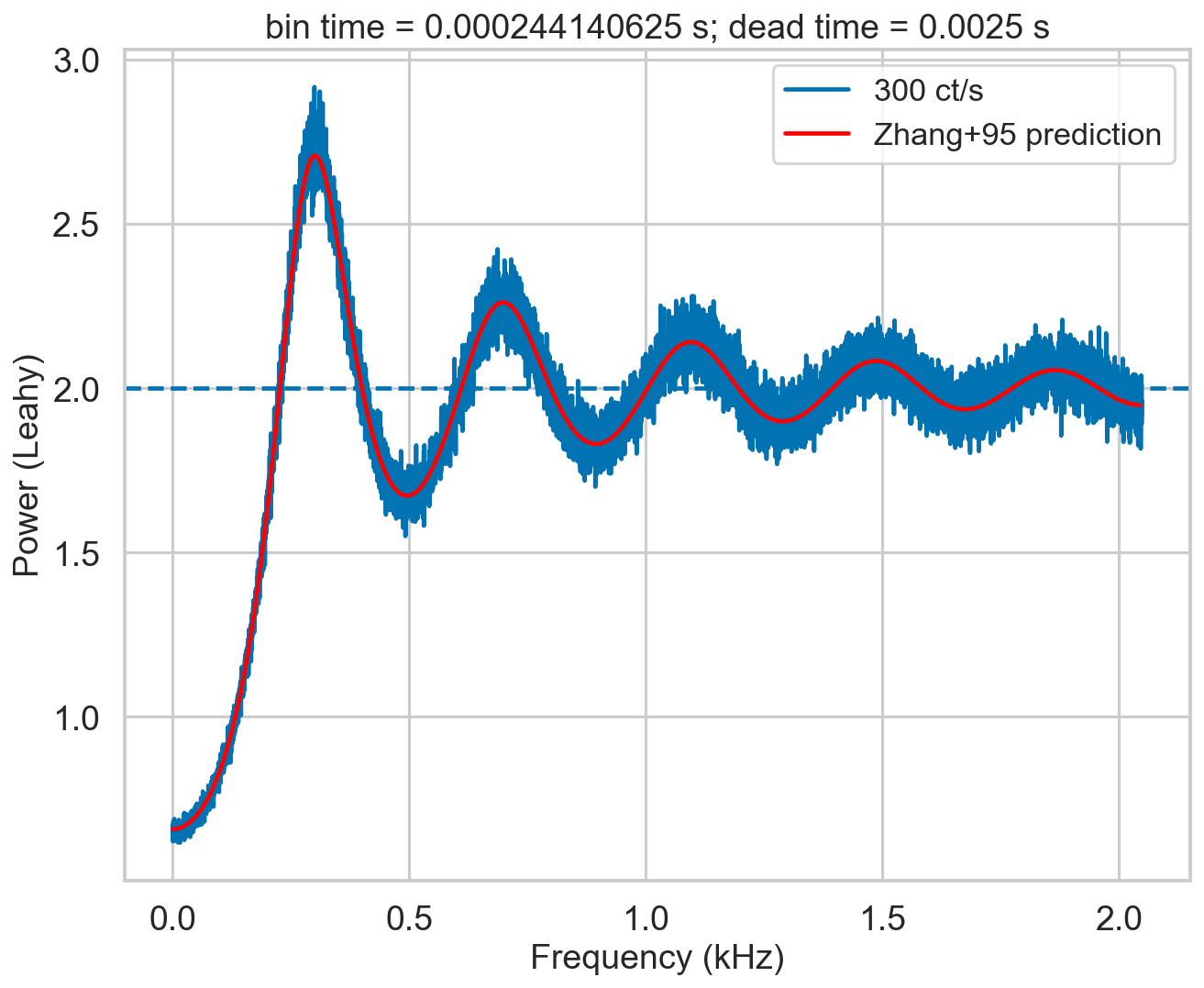
[18]:
deadtime_fun = interp1d(zh_f, zh_p, bounds_error=False,fill_value="extrapolate")
plt.figure()
plt.plot(pds.freq, pds.power / deadtime_fun(pds.freq), color='r', zorder=10)
[18]:
[<matplotlib.lines.Line2D at 0x7f8c6f9bd0d0>]
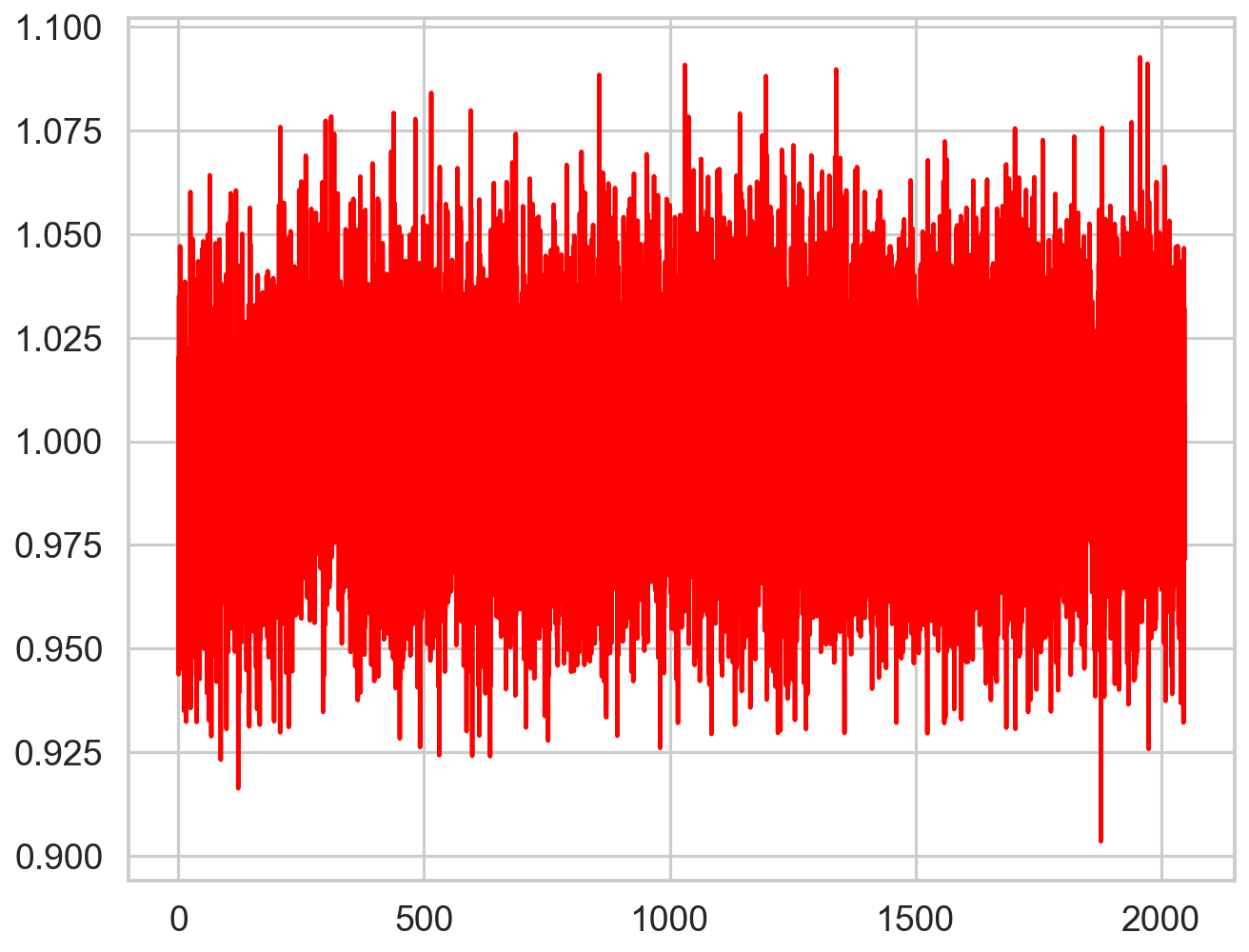
[ ]: